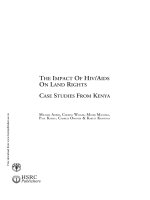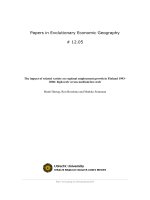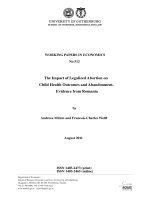The impact of online searches on consideration set formation and consumer choice
Bạn đang xem bản rút gọn của tài liệu. Xem và tải ngay bản đầy đủ của tài liệu tại đây (583.42 KB, 144 trang )
THE IMPACT OF ONLINE SEARCHES ON
CONSIDERATION SET FORMATION AND
CONSUMER CHOICE
Zhao Hongyu
(Master in Economics, Fudan University)
A THESIS SUBMITTED
FOR THE DEGREE OF PHD OF MARKETING
DEPARTMENT OF MARKETING
NATIONAL UNIVERSITY OF SINGAPORE
2008
i
Acknowledgements
I am indebted to a great number of people who generously offered advice,
encouragement, inspiration and friendship through my time at National University
of Singapore.
First of all, I would dedicate my deepest gratitude to my supervisors, Professor
Jeongwen Chiang who introduced me into a challenging but interesting research
area and provided the initial guidance for my dissertation work, and Professor
Surendra Rajiv who provide vital input and invaluable insights for my research. I
can not imagine the completion of this work without their encouragement and
support.
Thank you to the other faculty members who have helped me along the way.
Professor Juinkuan Chong who is my mentor for coursework and also a good
advisor for research work. Professor Junhong Chu who has been a friend and
generously shared her personal experience of doing research. Professor Trichy
Krishnan who always encouraged me by showing all-time enthusiasm towards
academic research.
Thank you to all the friends and colleagues who have made my PhD student life a
whole lot more enjoyable. Cheng and Zhixing for spending time discussing topics
varying from research to human nature and providing regular doses of
encouragement. Shangfei, Suman and Sun Li for their availability and patience in
ii
listening to my research ideas which very often turned out to be just mindless
talks.
Finally, thanks to my family who provided me with more love and support than I
would otherwise think possible. To my mother who knows nothing about
academic research but never questioned my decision, determination and
capability of pursuing high education. To my father who has been influencing and
supporting my academic pursuits as long as I can remember, and who has
tremendously influence on who I am. Though he is not around to see my complete
my education, but he would have been proud.
iii
Table of Contents
TABLE OF CONTENTS III
SUMMARY V
LIST OF TABLES VII
LIST OF FIGURES VIII
LIST OF SYMBOLS IX
CHAPTER 1: INTRODUCTION 1
CHAPTER 2: LITERATURE REVIEW 7
2.1 CONSUMER CHOICE 7
2.2 CONSIDERATION SET 9
2.3 INTERNET USE AND ITS IMPACT ON CONSUMER CONSIDERATION AND CHOICE 16
CHAPTER 3: MODELS AND ESTIMATION 24
3.1 DECISION PROCESS AND MODEL ASSUMPTIONS 25
3.1.1 Conceptual description of the decision process 25
3.1.2 Model assumptions 27
3.2 MODEL FORMULATION 29
3.2.1 Information on Search Attributes and Category Consideration 29
3.2.2 Information on Experience Attributes and Model Consideration 34
3.2.3 Choice Decision 40
3.2.4 Overall Decision 41
3.3 MODEL IDENTIFICATION 42
3.3.1 Identification of Multivariate Probit Model 42
3.3.2 Identification of the Multinomial Probit Model 44
3.3.3 Identification of the Multi-Stage Multivariate and Multinomial Probit
Models 45
3.4 DRAWING ALGORITHM 48
CHAPTER 4: DATA 53
4.1 J.D. POWER 2001 VEHICLE SHOPPING SURVEY DATA 54
4.1.1 The Luxury Segment 55
4.1.2 Consumer Demographics 60
4.1.3 Consideration Set and Internet Use 61
4.2 VEHICLE ATTRIBUTE DATA 66
CHAPTER 5: EMPIRICAL FINDINGS 69
5.1 VARIABLES DESCRIPTION 70
iv
5.2 MODEL COMPARISON 76
5.2.1 Decision Structure Comparison 76
5.2.2 Internet Effect Comparison 79
5.3 MODEL ESTIMATES 81
5.3.1 Internet Effects 82
5.3.2 State Dependence 84
5.3.3 Consumer’s Attribute Preference 86
5.3.4 Other Variables Affecting Consideration Cost 87
5.3.5 Unobservable Factors 87
5.4 MANAGERIAL IMPLICATIONS 89
5.4.1 Consideration Set Entropy 89
5.4.2 Consideration Set Composition 92
CHAPTER 6: CONCLUSION 99
6.1 SUMMARY 99
6.2 CONTRIBUTIONS 100
6.3 RESEARCH DIRECTIONS 102
6.4 CONCLUSION 106
BIBLIOGRAPHY 108
APPENDIX I: FULL CONDITIONAL POSTERIOR DISTRIBUTIONS 120
APPENDIX II: FIGURES AND TABLES 124
v
Summary
The Internet has been widely adopted for product information search. We have
substantial understanding that the availability of the low-cost price information on
the Internet can increase the consumer’s price sensitivity and drive down the
market price. However, we lack the general view of how the use of the Internet,
especially the search for non-price information, would affect consumer choice.
Therefore, we extend the extant literature to investigate the impact of the online
information search on consumer choice decision, especially the consideration set
formation decision. We also examine the heterogeneity in the websites in terms of
the types of information they deliver and how the difference would have distinct
effects on the individual consideration and choice decision.
We apply the multivariate Probit model to model consumer’s consideration
decision. The empirical evidences we find from the JD Power New Vehicle
Shopping Survey data show that a) the use of the Internet to search for vehicle
information leads to more diversified consideration set; c) the diversification of
the consideration set due to the Internet use is because of the increase in
considering unfamiliar vehicle categories and models; c) the Internet is not
homogeneous in terms of its influence on the consideration decision.
The literature has a lot of discussion on how the low-cost online price
information can influence consumer choice. We further the research in the area by
vi
examining the influence of both online price and non-price information on
consumer’s consideration and choice decision. We also differentiate the effects of
different types of websites. The proposed 3-stage choice decision model also
contributes to the choice model literature by explicitly modeling a consumer’s
decision to search for search attributes and experience attributes.
vii
List of Tables
Table 2.1 Marketing Literature on Internet Impact…………………………… 22
Table 4.1 Segment of Replaced, Considered and Purchased Vehicles …………56
Table 4.2 Vehicle Models in the Luxury Car Segment………………………….57
Table 4.3 Internet Use for Automotive Information Search – Total Replacement
Sample ………………………………………………………………………….58
Table 4.4 Internet Use for Automotive Information Search – Luxury Car Only
Sample………………………………………………………………………… 58
Table 4.5 Statistics on Consumer Demographics – Total Replacement Sample 59
Table 4.6 Statistics on Consumer Demographics – Luxury Car Sample……… 59
Table 4.7 Consideration Set Size……………………………………………… 62
Table 4.8 C-Set Composition Comparison I – Auto Internet User vs. Non-User
(Luxury Car Only Sample) ……………………………………………… ……63
Table 4.9 C-Set Composition Comparison II – Independent vs. Manufacturer Site
(Luxury Car Only Sample)………………………………………………… …65
Table 4.10 Vehicle Attribute Summary Statistics……………………………….67
Table 5.1 Rotated Factor Loadings for Vehicle Shopping Characteristics…… 74
Table 5.2 Competing Models – Decision Structure…………… ………………77
Table 5.3 Consideration Set Component Hit Rate – Decision Structure Models.78
Table 5.4 Choice Hit Rate – Decision Structure Models …………….……… 78
Table 5.5 Competing Models – Internet vs. No Internet……………………… 80
Table 5.6 Consideration Set Component Hit Rate – Internet vs. No Internet
Models………………………………………………………………………… 80
Table 5.7 Choice Hit Rate – Internet vs. No Internet Models………………… 80
viii
List of Figures
Figure 2.1 The Internet-Related Choice Decision Structure 21
Figure 3.1: Mechanism for Drawing Category and Model Consideration Latent
Utilities 52
Figure 5.1: Average C-Set Entropy Values for Different Internet Usage Scenarios
91
Figure 5.2: Number of Categories Considered for Different Internet Usage
Scenarios 92
Figure 5.3: Consideration Probability of Vehicle Categories for Different Internet
Usage Scenarios 93
Figure 5.4: Consideration Probability of Vehicle Categories among American Car
Replacements 95
Figure 5.5: Consideration Probability of Vehicle Categories among European Car
Replacements 95
Figure 5.6: Consideration Probability of Vehicle Categories among Asian Car
Replacements 95
Figure 5.7: Average C-Set Entropy Values for Different Independent Site Visit
Scenarios 96
Figure 5.8: Share of Vehicle Models from Different Categories for Manufacturer
Site Visit Scenarios 97
ix
List of Symbols
i
denotes an individual consumer
m
denotes a vehicle category,
1, ,
m M
=
…
j
denotes a vehicle alternative,
1, ,
j J
=
…
Category Consideration
1
i
C
is consumer
i
’s category consideration set
1
im
c
is an indicator of consumer
i
’s consideration of category
m
(equals to
1 if category
m
is considered, and 0 otherwise)
1*
im
c
is the perceived net utility of considering category
m
by consumer
i
1*
im
Utility
is the perceived utility of considering category
m
by consumer
i
1*
im
Cost
is the perceived cost of considering category
m
by consumer
i
m
I
is a vector of category-specific dummies
1
m
X
is a vector of attribute values of category
m
1
im
Cost
is a vector of explanatory variables which affect perceived consideration
cost
γ
is a vector of category-specific constant term parameters
i
γ
is a vector of category-specific constant term parameters for consumer
i
β
is a vector of attribute preference parameters
i
β
is a vector of attribute preference parameters for consumer
i
ρ
is a vector of cost factor parameters
i
D
consumer
i
’s demographics
i
Z
consumer
i
’s shopping characteristics
1
im
ε
multivariate-normal distributed variables at category consideration stage
x
1
Σ
covariance of random disturbance term
1
im
ε
Alternative Consideration
2
i
C
is consumer
i
’s alternative consideration set
2
ij
c
is an indicator of consumer
i
’s consideration of alternative
j
(equals
to 1 if alternative
j
is considered, and 0 otherwise)
2*
ij
c
is the perceived net utility of considering alternative
j
by consumer
i
1
( )
im j
c is an indicator of consumer
i
’s consideration of category
m
which
alternative
j
belongs to (equals to 1 if category
m
is considered, and
0 otherwise)
2*
ij
Utility
is the perceived utility of considering alternative
j
by consumer
i
2*
ij
Cost
is the perceived cost of considering alternative
j
by consumer
i
j
I
is a vector of alternative-specific dummies
2
ij
X
is a vector of attribute values of alternative
j
perceived by consumer
i
2
ij
Cost
is a vector of explanatory variables which affect perceived consideration
cost
i
λ
is a vector of alternative-specific constant term parameters for consumer
i
i
β
is a vector of attribute preference parameters for consumer
i
κ
is a vector of cost factor parameters
2
ij
ε
multivariate-normal distributed variables at alternative consideration
stage
2
Σ
covariance of random disturbance term
2
ij
ε
Choice
ij
y
is an indicator of consumer
i
’s choice
ij
u
is the net utility of choosing alternative
j
by consumer
i
xi
3
ij
X
is a vector of attribute values of alternative
j
perceived by consumer
i
3
ij
ε
is independent normally distributed variables at choice stage
3
Σ
covariance of random disturbance term
3
ij
ε
Drawing Algorithm
Θ
a set of utility and cost variable estimates
Ψ
a complete set of model estimates
α
working parameter
1
Chapter 1: Introduction
The Internet has been expanding rapidly in the past decade and has been widely
adopted by consumers as one of the media for shopping. In 1997, 2001, and 2003,
the Current Population Survey (CPS) conducted by the U.S. Census Bureau
included a section on computer ownership and Internet use. According to the 1997
survey, among the population aged 18 and above the penetration rate for the
Internet was 22.1%. This jumped to 55.3% in 2001 and further increased to 59.5%
in 2003. The latest estimate of the number of Internet users in the U.S., given by
Internet World Stats in June 2007 (InternetWorldStats.com), was 209 million, with
a penetration rate of 69.2%. In addition to the large increase in the number of
adopters, increasing numbers of Internet users carry out purchase-related
activities online. The CPS survey results show that 74.8% and 78.1% of adult
Internet users browsed the Internet for information on products and services in
2001 and 2003, respectively. In both years, finding information on products and
services was the second most mentioned purpose of Internet use, slightly behind
e-mails. What’s more, the Internet is not only used as an information source, but
also as a transaction platform, with more consumers making purchases online. In
2003, 54.2% of adult Internet users purchased products or services online, up
from 46.0% in 2001 (U.S. Census Bureau, 1997, 2001, 2003).
2
The proliferation of the Internet and the availability of online products and
services have had a huge impact on consumer choice behavior. Purchase behavior
has changed completely due to the distinctive features of online retailers, as
compared with bricks-and-mortar shops. For example, instead of going to music
stores and looking for newly released albums, consumers can order CDs online
and have them delivered to their homes. Another feature of the Internet is that it
allows consumers to listen to song samples online and then pay only to download
the few they like. This represents a fundamental change in consumer choice
behavior, because songs are now purchased in individual units rather than in
bundles. Moreover, an online music store can carry a huge and searchable
catalogue of digital music. Music fans can now easily locate the music produced
by their favorite, but not mainstream, bands, whose albums are often not available
in neighborhood record stores. This is another factor that makes the Internet more
attractive than traditional music stores (Corckett 1999).
The Internet has also changed the industry competition structure. Since its début
in the mid 90’s, the Internet has reshaped the business model of many industries.
Long-established companies have had to accept the fact that their rival start-ups
have grown into multi-million dollar businesses within years or even months, a
speed never before observed in the history of industry. For example, in the service
sector, the travel industry was one of the first to use – and is by far the most
deeply influenced by – the Internet. According to the 2002 Service Annual Survey
conducted by the U.S. Census Bureau, nearly a quarter (24.1%) of total sales in
3
the travel industry came from online transactions in 2002 (Dinlersoz and
Hernández-Murillo 2005). The transaction costs for travel reservations are much
lower online than offline, and travel agents “have lost at least 10% to 15% of sales
to the Internet over the past [few] years” (Hof, McWilliams and Saveri 1998).
The quick emergence of the Internet and its increasing influence on consumer
choice behavior and industry competition have attracted researchers in the
marketing field to study the Internet and its impact. Yet, most of this research
focuses on consumer online price-search behavior and changes in price
competition among retailers due to Internet searches (e.g. Chen, Iyer and
Padmanabhan 2002; Iyer and Pazgal 2003; Lynch and Ariely 2000; Scott Morton,
Zettelmeyer and Silva-Risso 2001; Zettlemeyer, Scott Morton and Silva-Risso
2006). There is very limited discussion of how online searches, for both price and
quality information, alter a consumer’s consideration and choice of various brands
and alternatives (with the exception of Wu and Rangaswamy 2003). Also, few
studies examine the profound impact that Internet use has had on manufacturer
competition.
Because consumer choice is a multi-stage process, to achieve a better
understanding of the Internet’s impact on it, this thesis focuses on how an Internet
search, particularly an online search for non-price information, changes a
consumer’s consideration and choice decision. To analyze the research questions,
J.D. Power 2001 New Vehicle Shopper Survey data are applied to the empirical
analyses. These data record respondents’ Internet use behavior and the
4
consideration and choice outcomes of their new vehicle shopping. The key
research questions and their contribution to the literature are as follows.
1. How will the low-cost information that is acquired from the Internet influence
the consumer consideration decision in terms of consideration set size and
similarity among the components in the consideration set?
An examination of the Internet’s impact on the consideration decision is in
response to calls for research on the “shape” of consideration set, that is,
whether similar or dissimilar components tend to appear together in a
consideration set and under what conditions (Roberts and Nedungadi 1995;
Roberts and Lattin 1997). It is important to investigate the factors that reshape
consideration set composition, because any changes that occur at the
consideration stage will be passed on to all of the subsequent choice decisions.
This is a worthwhile attempt to study consumer Internet use and search
behavior on the “shape” of consideration set.
Very little work has been done on the influence of Internet use on a
consumer’s consideration formation. The only exception is Wu and
Rangaswamy (2003). They examine the way in which the use of two online
search functions, sorting and forming personal lists, affect the perceived
uncertainty in consideration utility. However, the limited number of online
search functions and grocery shopping samples restrict the generalizability of
their estimation results for an analysis of industry competition.
5
2. Do the large numbers of Web sites have a homogeneous effect on consumer
consideration and choice decisions? Increasing numbers of Web sites provide
a massive amount of information on product price and quality, and many of
these sites specialize in only one product category. Previous literature
differentiates the content of the information (price versus quality) and the
distinct roles that these play in competition among retailers (Lynch and Ariely,
2000). This thesis clearly demonstrates that heterogeneity in another
dimension of product information, that is, information format, can have varied
effects on the consideration of different groups of automobile vehicles.
3. How will changes in consumer consideration and choice behavior further
influence the competition structure of the automobile industry? The marketing
literature emphasizes the influence of the Internet on price competition among
retailers. Most of these studies put forward the argument that the Internet will
introduce intensive price competition among retailers (Chen, Iyer, and
Padmanabhan, 2002; Iyer and Pazgal, 2003) or that there are situations in
which the Internet will reduce price competition (Lal and Sarvary, 1999;
Lynch and Ariely, 2000). This thesis takes a different approach by modeling
individual consumer’s choice decision and examines the Internet’s impact on
the competition structure of manufacturers at both the consumer consideration
and choice stages to provide a new and interesting argument about trends in
the automobile industry.
The rest of this thesis is arranged as follows. Chapter 2 briefly reviews the
6
literature on the consumer consideration and choice decision and that on
information searches and Internet use. Chapter 3 develops the model and
discusses model identification and estimation issues. Chapter 4 describes the data
used for model calibration, and Chapter 5 presents the empirical results, key
findings, and managerial implications. Chapter 6 provides a summary and a
discussion of future research.
7
Chapter 2: Literature Review
This research focuses on how online product information affects the consumer
consideration and choice decision in automobile purchases. This chapter reviews
the literature on the choice model and research on Internet use and its influence
on the consumer choice decision and market structure.
2.1 Consumer Choice
Consumers make brand choices according to the rule of utility maximization: that
is, they select the brand with the highest utility. Based on the utility maximization
rule, Guadagni and Little (1983) empirically calibrate a brand choice model on
scanner panel data that is able to deduce a consumer’s price sensitivity and loyalty
parameters from the observed choice outcome. For simplicity, they assume that
unobservable utility factors follow the extreme value distribution that produces
the Logit choice model. Although the Logit setting provides close-form
formulation of choice probability, it also suffers from the IIA (independence from
irrelevant alternatives) problem (Debreu, 1960). To overcome the IIA restriction,
researchers began to analyze consumer brand choice by building models with a
more flexible variance structure, and the often-used model specification is to
assume that the utility errors follow multivariate normal distribution (Kamakura
and Srivastava 1984; Papatla and Krishnamurthi 1992; Chintagunta 1992). The
8
non-zero covariance elements are able to capture the correlations in the
unobserved factors among the choice alternatives.
Fader and Hardie (1996) advance the choice model literature by decomposing the
alternative utility into consumer preferences for various product attributes. The
utility of a choice alternative then depends on the alternative’s attribute values and
the importance that a consumer allocates to its various attributes. The construct of
utility from the weighted addition of product attributes makes the model
parsimonious and hence applicable to the analysis of choice decision scenarios
with large numbers of alternatives. By comparing the attribute similarity among
new and incumbent brands, the model also improves the prediction of market
share change due to new brand entry.
To capture consumer heterogeneity in price sensitivity and attribute preference,
researchers either assume that the model coefficients are segment-specific (Fader
and Hardie 1996; Gupta and Chintagunta 1994; Kamakura and Russell 1989) or
that they are randomly distributed across the population (Chintagunta, Jain and
Vilcassim 1991). The empirical results show that choice models that incorporate
consumer heterogeneity perform better than those that do not (Fader and Hardie
1996; Kamakura and Russell, 1989). Moreover, preference for brand attributes is
not only individual-specific, but also situation-specific. Yang, Allenby and Fennell
(2002) show that a consumer’s brand preferences may change according to the
consumption occasion.
9
The choice models we have just reviewed are one-stage models. One-stage choice
models assume that consumers have the complete attribute information of all of
the alternatives in the market. Consequently, information search activity and
information acquisition cost are not relevant to the choice decision. One-stage
choice models also assume that consumers have unlimited cognitive resources
and are able to process all of the product information before they make their
choice decisions. However, neither the complete prior knowledge nor the
unlimited processing capability assumption is realistic. Two-stage choice models
with consideration set formation as the pre-choice stage provide a solution to the
above-mentioned limitations of one-stage choice models.
2.2 Consideration Set
A consideration set is the set of alternatives that are considered immediately prior
to choice and consist of goal-satisfying alternatives that are salient or accessible
on a particular purchase occasion (Shocker et al. 1991; Andrews and Srinivasan
1995).
The empirical research demonstrates that the two-stage choice model with both
consideration and choice phases is superior to the one-stage choice-only model in
terms of model fitting and the unbiased estimation of the model parameters. First,
the two-stage model performs better than the one-stage model in terms of model
fitting. Roberts and Lattin (1991) empirically compare a two-stage model that
incorporates a consideration set formation stage with two one-stage models
10
(consideration only and choice only). They obtain laboratory data with
self-reported consideration and choice for ready-to-eat cereals. The validity test
shows that the proposed two-stage model performs better than the two one-stage
models in market share prediction. Subsequently, Andrews and Srinivasan (1995)
confirm the improvement in the goodness-of-fit of the two-stage model over that
of the one-stage model with scanner panel data from yogurt purchases.
Second, the omission of a consideration set can lead to biased estimation of the
marketing mix effect on consumer choice decisions. Because consumers only
respond to price variations in the alternatives in the consideration set, rather than
in the universal set, price sensitivity estimates would be biased if the model does
not include consideration set formation as an intermediate step of the consumer
choice decision (Bronnenberg and Vanhonacker 1996). Chiang, Chib and
Narasimhan (1999) demonstrate that the loyalty and brand constants would be
overestimated, and the parameters of the marketing mix variables underestimated,
if the two-stage decision process is modeled as a one-stage process. They also
find that consumer heterogeneity in brand and attribute preference is smaller after
controlling for it in the consideration set component. The consideration set is also
essential to obtain an unbiased evaluation of the impact of new product
introduction on the choice of incumbent brands (Jedidi, Kohli and DeSarbo 1996).
As they do when making a choice decision, consumers also make a consideration
decision according to the utility maximization rule. Hauser and Wernerfelt (1990)
introduce a utility-cost framework to model the consideration decision. A
11
consumer includes an alternative into a consideration set if the expected utility of
considering this alternative is larger than the expected cost of searching for and
evaluating it. The consideration utility depends on the brand attribute performance
(Roberts and Lattin 1991) and the consumer’s uncertainty of the attribute values
(Mehta, Rajiv and Srinivasan 2003; Wu and Rangaswamy, 2003). In addition to
product attributes, the marketing mix, such as promotions, features, and displays,
may also affect the perceived consideration utility (Andrews and Srinivasan 1995;
Nierop et al 2004). On the cost side, a consumer faces both information search
and evaluation costs. The individual factors that can explain consumer
heterogeneity in search and evaluation costs include income, age, and education
(Ratchford, Lee and Talukdar 2003), and a consumer with lower search and
evaluation costs can afford to consider more alternatives (Hauser and Wernerfelt
1990). Consumer motives for constructing a consideration set is to justify the
costly information search activities, their limited information processing
capability, or both.
The first motive for forming a consideration set is to save information search cost.
For consumers who do not have complete product attribute information, the ways
to collect that information include learning from their own personal consumption
history (Nelson 1970) or conducting an external search. This accumulated
information is useful to reduce the perceived uncertainty in product quality
(Erdem and Keane 1996; Meyer 1982; Roberts and Urban 1988) and/or retail
price (Mehta, Rajiv and Srinivasan 2003; Stigler 1961). Although knowledge of
12
product performance is critical for a consumer to form an evaluation and make a
choice decision, the high acquisition cost of product information determines that
it is not optimal for a consumer to search all of the available alternatives in the
market (Stigler 1961; Moorthy, Ratchford and Talukdar 1997).
Stigler (1961) demonstrates that there are an optimal number of retailers to be
searched for price information. The stopping point of the search activities depends
on a comparison of the search cost and the marginal returns from the search.
Metha, Rajiv and Srinivasan (2003) examine the relationship between consumer
information search activities and the consideration decision. Their model assumes
that the consumer learns about product quality through the consumption
experience but searches for price information at retail stores on each purchase
occasion. The set of alternatives for which the consumer decides to search retail
prices is defined as the consideration set. In this model, the dispersion of market
prices influences the expected search utility, and the accessibility of the price
information affects the search cost. The size of a consideration set is larger when
the expected search utility is higher and the search cost is lower. Other empirical
studies also confirm that the total number of searches is larger when the search
cost is lower or the search efficacy is higher (e.g. Moorthy, Ratchford and Talukda
1997).
Information search cost involved in the information search would restrain the
number of alternatives searched and considered. The other reason to restrict the
number of brands considered is the high information processing cost. After
13
searching for product information, a consumer has to process the incoming
information and evaluate the various alternatives. This high evaluation cost thus
limits the number of alternatives a consumer wants to consider.
Consumers have limited cognitive capability to evaluate a large set of alternatives
when making a choice decision (Bettman 1979; Cowan 1988). To overcome this
limitation in cognitive capacity, a consumer applies low-cost heuristics to
eliminate certain alternatives at the early stage and to form a consideration set
with a manageable number of alternatives (Bettman, Luce and Payne 1998). The
cognitive cost increases with the number of alternatives and attributes to process
(Bettman, Johnson and Payne 1991) and decreases with the perceived
comparability of the alternatives along the product attributes (Chakravarti and
Janiszewski 2003) and the situational accessibility of the brand and attribute
information (Nedungadi 1990). A consumer has to make a trade-off between
comparison cost and choice accuracy, because, in general, the consideration
heuristic that results in higher choice decision accuracy also requires a higher
evaluation cost (Shugan 1980).
Empirically, it is not easy to separate the evaluation cost from the search cost in
terms of their effects on the consumer consideration decision, as these two often
act together and move the results in the same direction. Without a direct measure
of the consumer’s expected search and evaluation costs, it is difficult to identify
the influence of each in the consideration decision. Therefore, most of the
two-stage choice models construct a total consideration cost, rather than









